1998 OPEL FRONTERA display
[x] Cancel search: displayPage 1282 of 6000

6E–165 ENGINE DRIVEABILITY AND EMISSIONS
DTC P0174 – Fuel Trim System Lean Bank 2
StepNo Ye s Va l u e ( s ) Action
101. Visually and physically inspect the throttle body,
intake manifold, EGR valve and the EGR feed pipe
for vacuum leaks.
2. Repair any vacuum leaks as necessary.
Did your inspection reveal a vacuum leak?
—Verify repairGo to Step 11
11Check the fuel for excessive water, alcohol, or other
contaminants (see
Diagnosis in Engine Fuel for
procedure) and correct the contaminated fuel condition
is present (see
Engine Fuel).
Was the fuel contaminated?
—Verify repairGo to Step 12
121. Visually and physically inspect the PCM injector
grounds, power grounds and sensor grounds to
ensure that they are clean, tight, and in their proper
locations.
2. If a faulty ground condition is present, correct it as
necessary.
Did your inspection reveal a condition requiring repair?
—Verify repairGo to Step 13
131. Disconnect the MAF sensor electrical connector.
2. Operate the vehicle in “closed loop” while
monitoring the “BANK 1 S.T. FUEL TRIM” displayed
on the Tech 2.
Does the “BANK 1 S.T. FUEL TRIM” value decrease to
near the specified value?
0%Go to Step 19Go to Step 14
14Perform the procedure in the ”Fuel System Pressure
Test” and repair fuel system problem if necessary.
Did the Fuel System Pressure Test isolate a condition
requiring repair?
—Verify repairGo to Step 15
151. Visually and physically inspect the intake manifold,
injector O-rings, EGR adapter, EGR valve and the
EGR feed pipes for vacuum leaks.
2. Repair any problem that is found.
Did your inspection reveal a problem?
—Verify repairGo to Step 16
16Visually and physically inspect the Bank 2 exhaust
manifold for leaks and loose or missing hardware and
correct any problem found.
Did your inspection reveal a problem?
—Verify repairGo to Step 17
17Perform the “Injector Balance Test,” and correct any
problem found (refer to
Fuel Metering System).
Did the Injector Balance Test isolate a problem?
—Verify repair Go to Step 18
181. Visually and physically inspect the Bank 2 HO2S 1
to ensure that it is installed securely and that the
Bank 2 HO2S 1 pigtail and wiring harness are not
contacting the exhaust or otherwise damaged.
2. If a problem is found, correct it as necessary.
Did your inspection reveal a problem?
—Verify repair
Refer to
Diagnostic
Aids
19Replace the MAF sensor.
Is the action complete?
—Verify repair—
Page 1284 of 6000

6E–167 ENGINE DRIVEABILITY AND EMISSIONS
Barometric pressure is greater than 72.5 kPa.
Mass air flow is between 2 g/second and 200 g/second.
Ignition voltage is above 9.5 volts.
Fuel system is in “closed loop.”
Action Taken When the DTC Sets
The PCM will illuminate the malfunction indicator lamp
(MIL) after the second consecutive trip in which the
failure is detected.
The PCM will store conditions which were present
when the DTC was set as Freeze Frame and in the
Failure Records data.
Conditions for Clearing the MIL/DTC
DTC P0175 can be cleared by using the Tech 2 “Clear
Info” function or by disconnecting the PCM battery
feed.
Diagnostic Aids
Check for the following conditions:
Poor connection at PCM – Inspect harness connectors
for backed -out terminals, improper mating, broken
locks, improperly formed or damaged terminals, and
poor terminal-to-wire connection.
Damaged harness – Inspect the wiring harness for
damage. If the harness appears to be OK, observe the
Bank 2 HO2S 1 display on the Tech 2 while moving
connectors and wiring harnesses related to the engine
harness. A change in the display will indicate the
location of the fault.
Reviewing the Failure Records Vehicle mileage since the
diagnostic test last failed may help determine how often
the condition that caused the DTC to be set occurs. This
may assist in diagnosing the condition.
Test Description
Number(s) below refer to the step number(s) on the
Diagnostic Chart.
2. DTCs other than P0172 and P0175 may indicate a
condition present which may cause a lean condition.
If this is the case, repairing the condition which
caused the other DTC will most likely correct the
DTC P0172/P0175.
4. If the DTC P0175 test passes while the Failure
Records conditions are being duplicated, the rich
condition is intermittent. Refer to
Diagnostic Aids or
Symptoms for additional information on diagnosing
intermittent problems.
Page 1285 of 6000
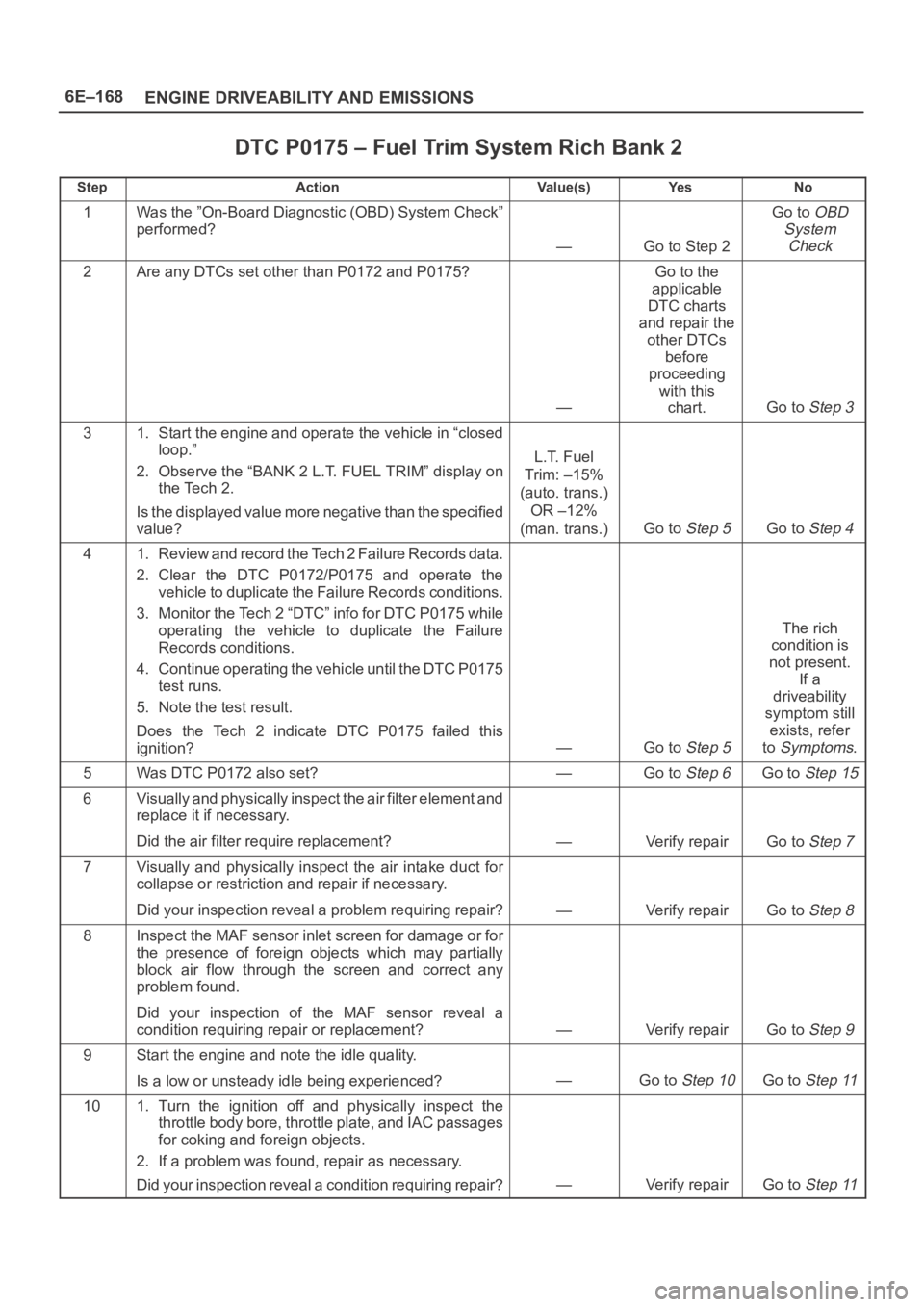
6E–168
ENGINE DRIVEABILITY AND EMISSIONS
DTC P0175 – Fuel Trim System Rich Bank 2
StepActionVa l u e ( s )Ye sNo
1Was the ”On-Board Diagnostic (OBD) System Check”
performed?
—Go to Step 2
Go to OBD
System
Check
2Are any DTCs set other than P0172 and P0175?
—
Go to the
applicable
DTC charts
and repair the
other DTCs
before
proceeding
with this
chart.
Go to Step 3
31. Start the engine and operate the vehicle in “closed
loop.”
2. Observe the “BANK 2 L.T. FUEL TRIM” display on
the Tech 2.
Is the displayed value more negative than the specified
value?
L.T. Fuel
Trim: –15%
(auto. trans.)
OR –12%
(man. trans.)
Go to Step 5Go to Step 4
41. Review and record the Tech 2 Failure Records data.
2. Clear the DTC P0172/P0175 and operate the
vehicle to duplicate the Failure Records conditions.
3. Monitor the Tech 2 “DTC” info for DTC P0175 while
operating the vehicle to duplicate the Failure
Records conditions.
4. Continue operating the vehicle until the DTC P0175
test runs.
5. Note the test result.
Does the Tech 2 indicate DTC P0175 failed this
ignition?
—Go to Step 5
The rich
condition is
not present.
If a
driveability
symptom still
exists, refer
to
Symptoms.
5Was DTC P0172 also set?—Go to Step 6Go to Step 15
6V i s u a l l y a n d p h y s i c a l l y i n s p e c t t h e a i r f i l t e r e l e m e n t a n d
replace it if necessary.
Did the air filter require replacement?
—Verify repairGo to Step 7
7Visually and physically inspect the air intake duct for
collapse or restriction and repair if necessary.
Did your inspection reveal a problem requiring repair?
—Verify repairGo to Step 8
8Inspect the MAF sensor inlet screen for damage or for
the presence of foreign objects which may partially
block air flow through the screen and correct any
problem found.
Did your inspection of the MAF sensor reveal a
condition requiring repair or replacement?
—Verify repairGo to Step 9
9Start the engine and note the idle quality.
Is a low or unsteady idle being experienced?
—Go to Step 10Go to Step 11
101. Turn the ignition off and physically inspect the
throttle body bore, throttle plate, and IAC passages
for coking and foreign objects.
2. If a problem was found, repair as necessary.
Did your inspection reveal a condition requiring repair?
—Verify repairGo to Step 11
Page 1286 of 6000
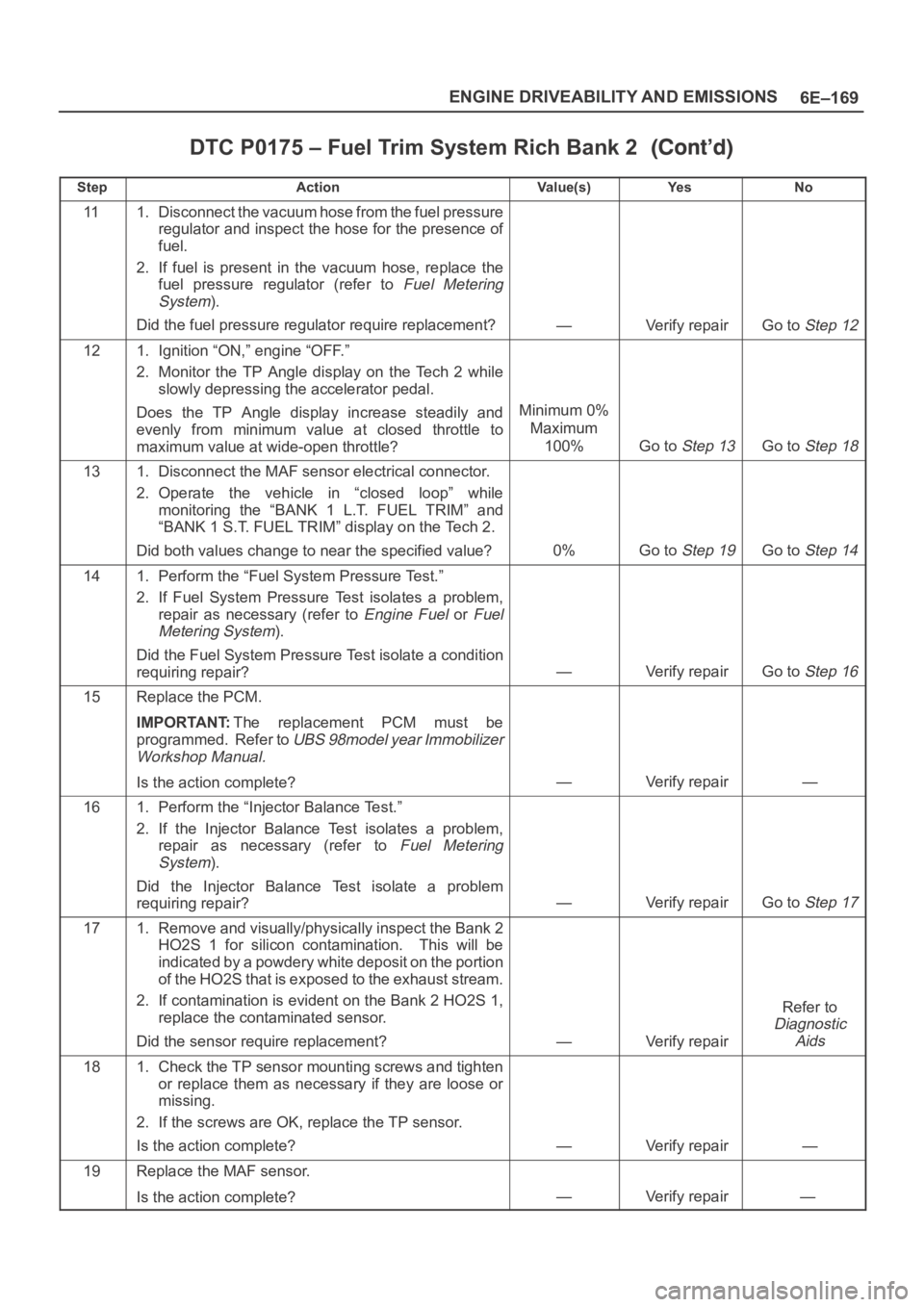
6E–169 ENGINE DRIVEABILITY AND EMISSIONS
DTC P0175 – Fuel Trim System Rich Bank 2
StepNo Ye s Va l u e ( s ) Action
111. Disconnect the vacuum hose from the fuel pressure
regulator and inspect the hose for the presence of
fuel.
2. If fuel is present in the vacuum hose, replace the
fuel pressure regulator (refer to
Fuel Metering
System
).
Did the fuel pressure regulator require replacement?
—Verify repairGo to Step 12
121. Ignition “ON,” engine “OFF.”
2. Monitor the TP Angle display on the Tech 2 while
slowly depressing the accelerator pedal.
Does the TP Angle display increase steadily and
evenly from minimum value at closed throttle to
maximum value at wide-open throttle?
Minimum 0%
Maximum
100%
Go to Step 13Go to Step 18
131. Disconnect the MAF sensor electrical connector.
2. Operate the vehicle in “closed loop” while
monitoring the “BANK 1 L.T. FUEL TRIM” and
“BANK 1 S.T. FUEL TRIM” display on the Tech 2.
Did both values change to near the specified value?
0%Go to Step 19Go to Step 14
141. Perform the “Fuel System Pressure Test.”
2. If Fuel System Pressure Test isolates a problem,
repair as necessary (refer to
Engine Fuel or Fuel
Metering System
).
Did the Fuel System Pressure Test isolate a condition
requiring repair?
—Verify repairGo to Step 16
15Replace the PCM.
IMPORTANT:The replacement PCM must be
programmed. Refer to
UBS 98model year Immobilizer
Workshop Manual.
Is the action complete?—Verify repair—
161. Perform the “Injector Balance Test.”
2. If the Injector Balance Test isolates a problem,
repair as necessary (refer to
Fuel Metering
System
).
Did the Injector Balance Test isolate a problem
requiring repair?
—Verify repairGo to Step 17
171. Remove and visually/physically inspect the Bank 2
HO2S 1 for silicon contamination. This will be
indicated by a powdery white deposit on the portion
of the HO2S that is exposed to the exhaust stream.
2. If contamination is evident on the Bank 2 HO2S 1,
replace the contaminated sensor.
Did the sensor require replacement?
—Verify repair
Refer to
Diagnostic
Aids
181. Check the TP sensor mounting screws and tighten
or replace them as necessary if they are loose or
missing.
2. If the screws are OK, replace the TP sensor.
Is the action complete?
—Verify repair—
19Replace the MAF sensor.
Is the action complete?
—Verify repair—
Page 1318 of 6000

6E–201 ENGINE DRIVEABILITY AND EMISSIONS
DTC P0341 – CMP Sensor Circuit Performance
StepNo Ye s Va l u e ( s ) Action
101. Check for poor connections at the PCM.
2. If a problem is found, repair it as necessary.
Was a problem found?
—Verify repairGo to Step 11
11Backprobe the PCM connector with a DVM to monitor
voltage on the camshaft position input signal circuit
while cranking the engine with the sensor connected.
(Use rubber band, tape, or an assistant to keep the
DVM lead in contact with the sensor terminal during this
test.)
Does the voltage toggle between the specified values?
4-0 VGo to Step 15Go to Step 12
121. Remove the CMP sensor from the engine front
cover (leave the sensor wiring connected).
2. Place a magnet on the CMP sensor.
(If you use a magnet that is too small to cover the face
of the sensor, test on every part of the sensor face
because only a small area will respond to this test.)
Does the DVM display a voltage near the specified
value?
0 VGo to Step 13Go to Step 14
13Replace the faulty or missing camshaft position sensor
magnet.
Is the action complete?
—Verify repair—
14Replace the camshaft position sensor.
Is the action complete?
—Verify repair—
15Replace the PCM.
IMPORTANT:The replacement PCM must be
programmed. Refer to
UBS 98model year Immobilizer
Workshop Manual.
Is the action complete?—Verify repair—
Page 1321 of 6000
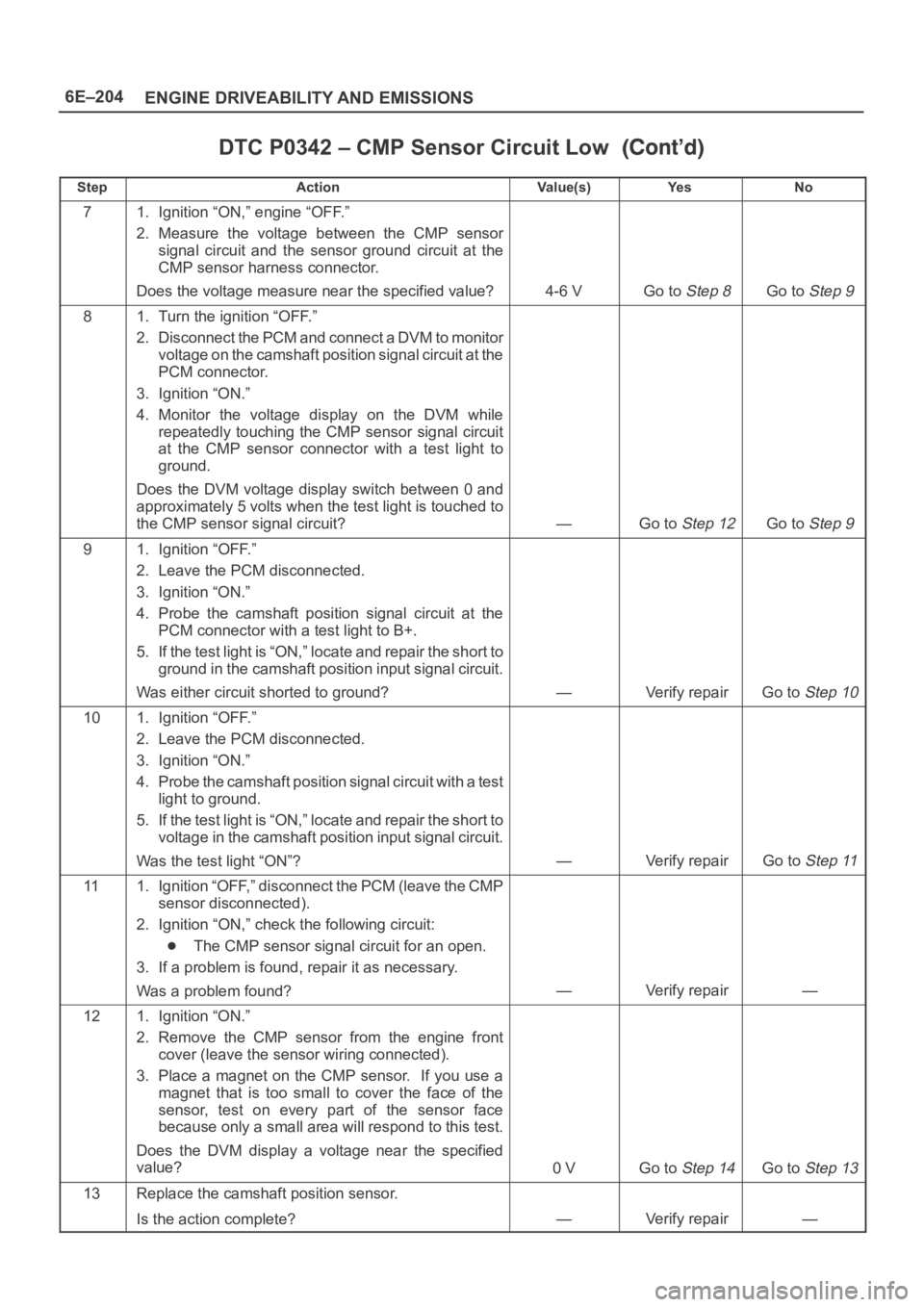
6E–204
ENGINE DRIVEABILITY AND EMISSIONS
DTC P0342 – CMP Sensor Circuit Low
StepNo Ye s Va l u e ( s ) Action
71. Ignition “ON,” engine “OFF.”
2. Measure the voltage between the CMP sensor
signal circuit and the sensor ground circuit at the
CMP sensor harness connector.
Does the voltage measure near the specified value?
4-6 VGo to Step 8Go to Step 9
81. Turn the ignition “OFF.”
2. Disconnect the PCM and connect a DVM to monitor
voltage on the camshaft position signal circuit at the
PCM connector.
3. Ignition “ON.”
4. Monitor the voltage display on the DVM while
repeatedly touching the CMP sensor signal circuit
at the CMP sensor connector with a test light to
ground.
Does the DVM voltage display switch between 0 and
approximately 5 volts when the test light is touched to
the CMP sensor signal circuit?
—Go to Step 12Go to Step 9
91. Ignition “OFF.”
2. Leave the PCM disconnected.
3. Ignition “ON.”
4. Probe the camshaft position signal circuit at the
PCM connector with a test light to B+.
5. If the test light is “ON,” locate and repair the short to
ground in the camshaft position input signal circuit.
Was either circuit shorted to ground?
—Verify repairGo to Step 10
101. Ignition “OFF.”
2. Leave the PCM disconnected.
3. Ignition “ON.”
4. Probe the camshaft position signal circuit with a test
light to ground.
5. If the test light is “ON,” locate and repair the short to
voltage in the camshaft position input signal circuit.
Was the test light “ON”?
—Verify repairGo to Step 11
111. Ignition “OFF,” disconnect the PCM (leave the CMP
sensor disconnected).
2. Ignition “ON,” check the following circuit:
The CMP sensor signal circuit for an open.
3. If a problem is found, repair it as necessary.
Was a problem found?
—Verify repair—
121. Ignition “ON.”
2. Remove the CMP sensor from the engine front
cover (leave the sensor wiring connected).
3. Place a magnet on the CMP sensor. If you use a
magnet that is too small to cover the face of the
sensor, test on every part of the sensor face
because only a small area will respond to this test.
Does the DVM display a voltage near the specified
value?
0 VGo to Step 14Go to Step 13
13Replace the camshaft position sensor.
Is the action complete?
—Verify repair—
Page 1324 of 6000
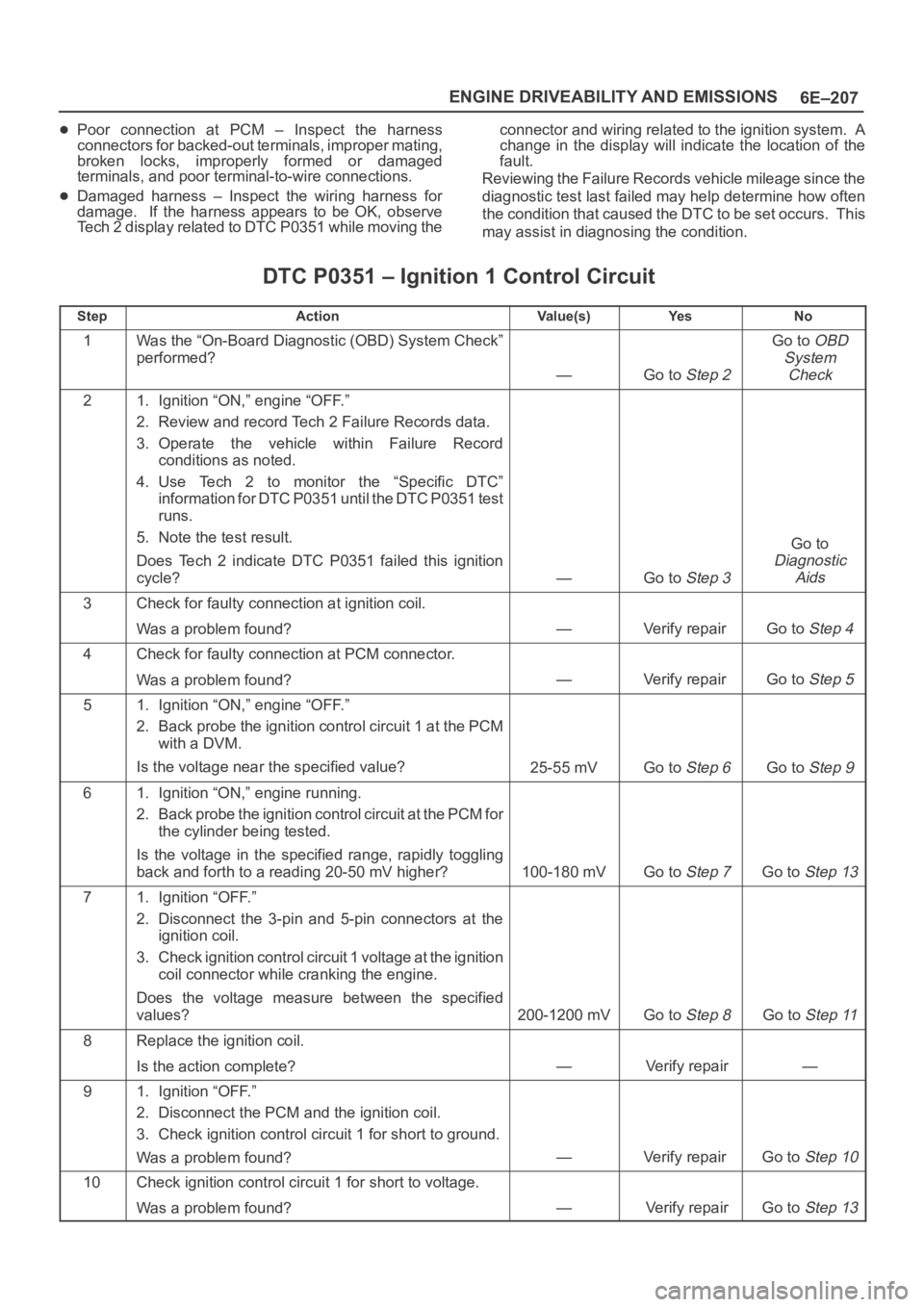
6E–207 ENGINE DRIVEABILITY AND EMISSIONS
Poor connection at PCM – Inspect the harness
connectors for backed-out terminals, improper mating,
broken locks, improperly formed or damaged
terminals, and poor terminal-to-wire connections.
Damaged harness – Inspect the wiring harness for
damage. If the harness appears to be OK, observe
Tech 2 display related to DTC P0351 while moving theconnector and wiring related to the ignition system. A
change in the display will indicate the location of the
fault.
Reviewing the Failure Records vehicle mileage since the
diagnostic test last failed may help determine how often
the condition that caused the DTC to be set occurs. This
may assist in diagnosing the condition.
DTC P0351 – Ignition 1 Control Circuit
StepActionVa l u e ( s )Ye sNo
1Was the “On-Board Diagnostic (OBD) System Check”
performed?
—Go to Step 2
Go to OBD
System
Check
21. Ignition “ON,” engine “OFF.”
2. Review and record Tech 2 Failure Records data.
3. Operate the vehicle within Failure Record
conditions as noted.
4. Use Tech 2 to monitor the “Specific DTC”
information for DTC P0351 until the DTC P0351 test
runs.
5. Note the test result.
Does Tech 2 indicate DTC P0351 failed this ignition
cycle?
—Go to Step 3
Go to
Diagnostic
Aids
3Check for faulty connection at ignition coil.
Was a problem found?
—Verify repair Go to Step 4
4Check for faulty connection at PCM connector.
Was a problem found?
—Verify repair Go to Step 5
51. Ignition “ON,” engine “OFF.”
2. Back probe the ignition control circuit 1 at the PCM
with a DVM.
Is the voltage near the specified value?
25-55 mVGo to Step 6Go to Step 9
61. Ignition “ON,” engine running.
2. Back probe the ignition control circuit at the PCM for
the cylinder being tested.
Is the voltage in the specified range, rapidly toggling
back and forth to a reading 20-50 mV higher?
100-180 mVGo to Step 7Go to Step 13
71. Ignition “OFF.”
2. Disconnect the 3-pin and 5-pin connectors at the
ignition coil.
3. Check ignition control circuit 1 voltage at the ignition
coil connector while cranking the engine.
Does the voltage measure between the specified
values?
200-1200 mVGo to Step 8Go to Step 11
8Replace the ignition coil.
Is the action complete?
—Verify repair—
91. Ignition “OFF.”
2. Disconnect the PCM and the ignition coil.
3. Check ignition control circuit 1 for short to ground.
Was a problem found?
—Verify repair Go to Step 10
10Check ignition control circuit 1 for short to voltage.
Was a problem found?
—Verify repairGo to Step 13
Page 1327 of 6000
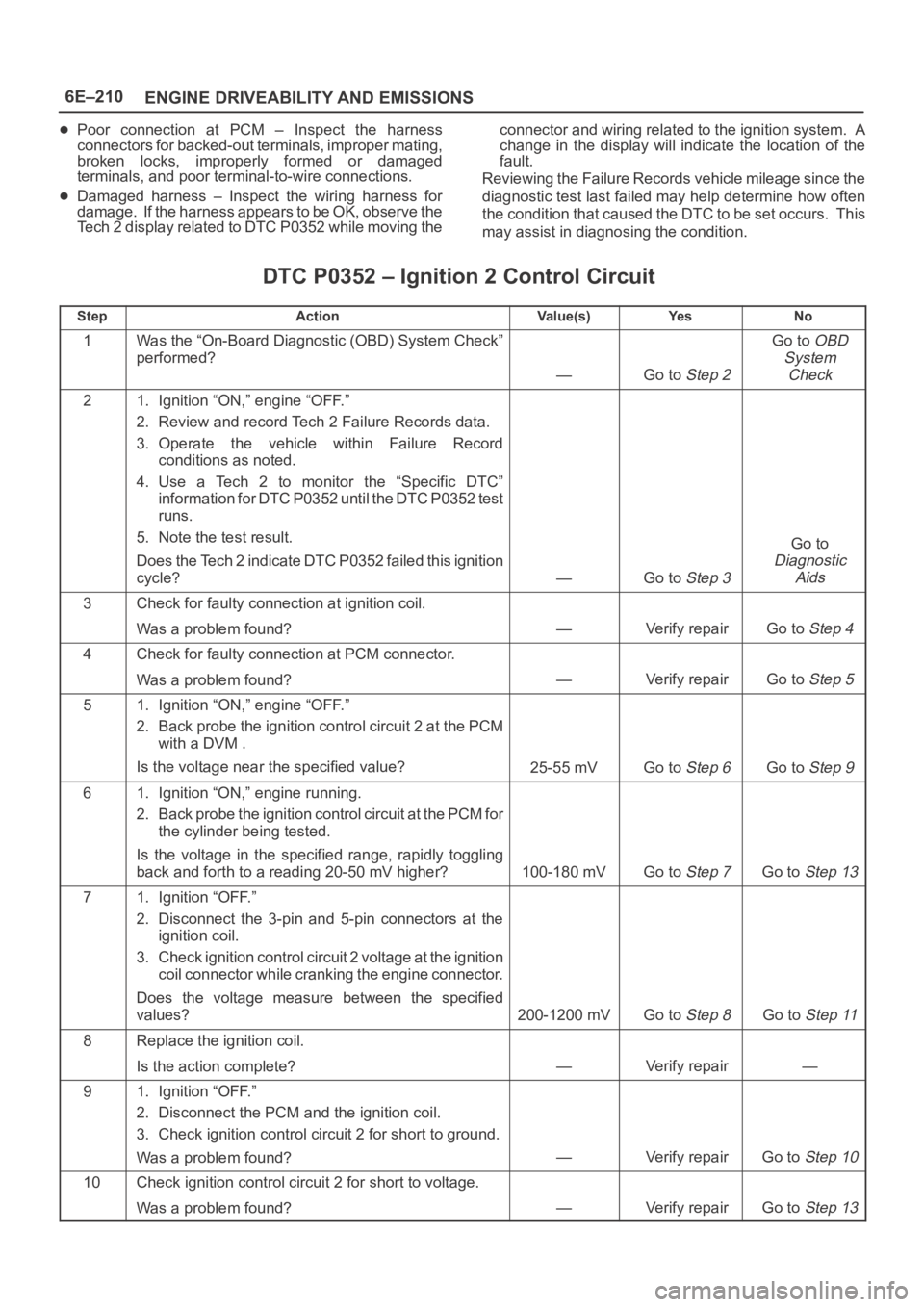
6E–210
ENGINE DRIVEABILITY AND EMISSIONS
Poor connection at PCM – Inspect the harness
connectors for backed-out terminals, improper mating,
broken locks, improperly formed or damaged
terminals, and poor terminal-to-wire connections.
Damaged harness – Inspect the wiring harness for
damage. If the harness appears to be OK, observe the
Tech 2 display related to DTC P0352 while moving theconnector and wiring related to the ignition system. A
change in the display will indicate the location of the
fault.
Reviewing the Failure Records vehicle mileage since the
diagnostic test last failed may help determine how often
the condition that caused the DTC to be set occurs. This
may assist in diagnosing the condition.
DTC P0352 – Ignition 2 Control Circuit
StepActionVa l u e ( s )Ye sNo
1Was the “On-Board Diagnostic (OBD) System Check”
performed?
—Go to Step 2
Go to OBD
System
Check
21. Ignition “ON,” engine “OFF.”
2. Review and record Tech 2 Failure Records data.
3. Operate the vehicle within Failure Record
conditions as noted.
4. Use a Tech 2 to monitor the “Specific DTC”
information for DTC P0352 until the DTC P0352 test
runs.
5. Note the test result.
Does the Tech 2 indicate DTC P0352 failed this ignition
cycle?
—Go to Step 3
Go to
Diagnostic
Aids
3Check for faulty connection at ignition coil.
Was a problem found?
—Verify repairGo to Step 4
4Check for faulty connection at PCM connector.
Was a problem found?
—Verify repairGo to Step 5
51. Ignition “ON,” engine “OFF.”
2. Back probe the ignition control circuit 2 at the PCM
with a DVM .
Is the voltage near the specified value?
25-55 mVGo to Step 6Go to Step 9
61. Ignition “ON,” engine running.
2. Back probe the ignition control circuit at the PCM for
the cylinder being tested.
Is the voltage in the specified range, rapidly toggling
back and forth to a reading 20-50 mV higher?
100-180 mVGo to Step 7Go to Step 13
71. Ignition “OFF.”
2. Disconnect the 3-pin and 5-pin connectors at the
ignition coil.
3. Check ignition control circuit 2 voltage at the ignition
coil connector while cranking the engine connector.
Does the voltage measure between the specified
values?
200-1200 mVGo to Step 8Go to Step 11
8Replace the ignition coil.
Is the action complete?
—Verify repair—
91. Ignition “OFF.”
2. Disconnect the PCM and the ignition coil.
3. Check ignition control circuit 2 for short to ground.
Was a problem found?
—Verify repairGo to Step 10
10Check ignition control circuit 2 for short to voltage.
Was a problem found?
—Verify repairGo to Step 13